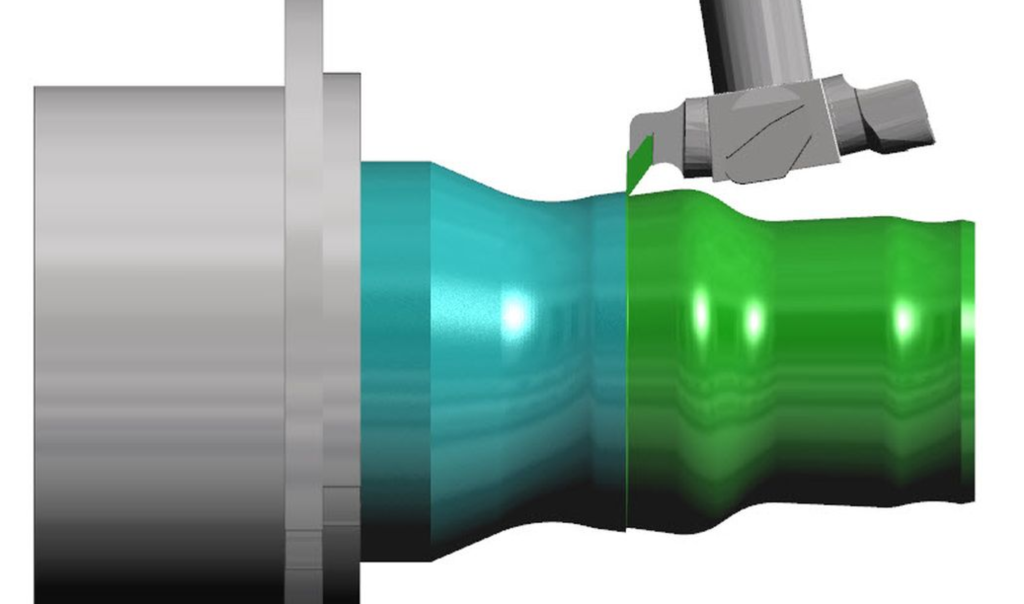Surfcam 2017 R2 Software
Surfcam 2017 R2 Software
The latest release of the Surfcam solution, by Vero Software, introduces a new turning cycle that includes B-axis movements while machining on a turning center. This new feature in Surfcam 2017 R2 allows greater accessibility when machining complex profiles by dynamically positioning the insert.

The latest release of the Surfcam solution, by Vero Software, introduces a new turning cycle that includes B-axis movements while machining on a turning center. This new feature in Surfcam 2017 R2 allows greater accessibility when machining complex profiles by dynamically positioning the insert.
Surfcam Brand Manager John Buehler notes that the toolholder is gouge-protected during deployment, and that users can attain additional control over the toolpath by deploying over-ride angles. "This new cycle can be used with all types of turning tools, and for both roughing and finishing operations."
There are nearly 20 upgrades available with Surfcam 2017 R2, including those for turning, milling, simulation and wire EDM functionality.
An improvement to the Surfcam Fixture Database makes it possible to measure fixtures and other workholding devices. "It's essential to be able to accurately measure the exact position and size of the fixture, as well as to clarify its relationship to components, stock and any other workholders," Buehler explains.
With an upgrade to Surfcam Feature Finding, information transmitted by CadLink is enhanced so that "Limits and Fit" data is now passed to the Surfcam feature. This support covers CREO, SOLIDWORKS and Inventor files. As well as showing the characteristic of the feature, this information also empowers strategy manager authors to capture and use the data when creating machining routines.
The Live Job Reports function was previously run as a Windows Service. Surfcam 2017 R2 swaps it to a desktop application, improving reliability when altering user profiles.
"With so many software tools available in Surfcam, it can sometimes be difficult to judge which commands to permanently fix on the interface, but the latest release overcomes this with a new Quick Search function," Buehler says. "Less common functionality can be easily located and deployed by simply searching the command library."
The 2017 R2 release continues Surfcam's evolution of updating cycle dialogs with pictures and context-sensitive help. "In this instance, Slot Milling, Project Flow Curves and Project Circular Pattern cycles have all been updated. This feature not only assists regular users to easily interpret infrequently used commands, but it also aids less familiar users to quickly understand fundamental functionality."
The Inspection Module offers what Buehler describes as "unparalleled ease of use and sophisticated probe path generation" for both in-process and end-item part inspection. "It provides a robust environment for on-machine probing, supporting a wide array of feature types, path creation and report generation."
Responding to the growing need for offline inspection and probing, Surfcam caters to CAM programmers and utilizes CAD models. Using a set of easy-to-use commands, the user creates a set of inspection features which are then converted into toolpath and simulated. This means the machine code macros are created via Surfcam's postprocessor.
The Machine Simulator benefits from two additional enhancements. The ability to pick the target component while using View Comparison was introduced in the previous release, and has now been enhanced so that users can now opt for "All components," which is especially useful when working with numerous parts on a multi-loaded fixture.
Secondly, a quicker, more convenient way of rewinding the toolpaths has been introduced for exiting the Machine Simulator: Rather than use the traditional menu option, users can now simply hold down the 'Shift' key.
Both the Roughing and Hole Drill cycles have been upgraded to be more consistent with existing functionality. Namely, when roughing to full depth, users no longer need to state a "cut increment" value. In previous releases, it was necessary to provide a figure.
Similar to the Roughing cycle, when set to "Use Current Stock," the 2017 R2 Hole cycle no longer requires a Z Level value, as the system automatically detects the start position for the toolpath.
Finally, for Wire EDM users, numerous enhancements have been made to the Machine Configurator. Support for multiple versions of EDM Expert is now available, and a new technology setting has been added, allowing cycles to automatically switch to the appropriate EDM Expert technology page.
The ACVision and Excetek postprocessors now have more options, giving greater user control.
Lastly, the Tagging functions now allow nonparallel movement when exiting a machining path. "This assists with better code output and allows a constant tag width along the entire part," Buehler says.





